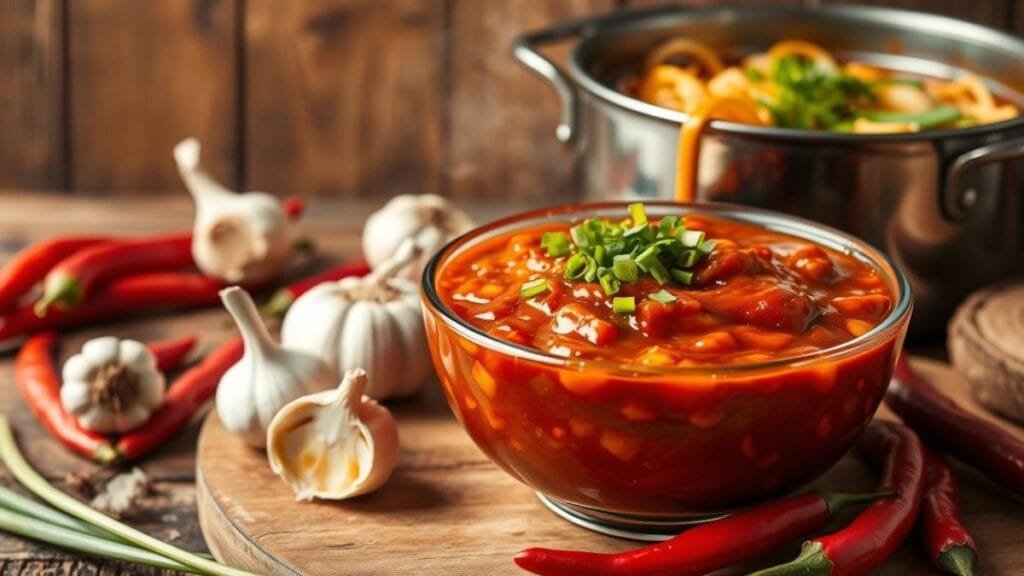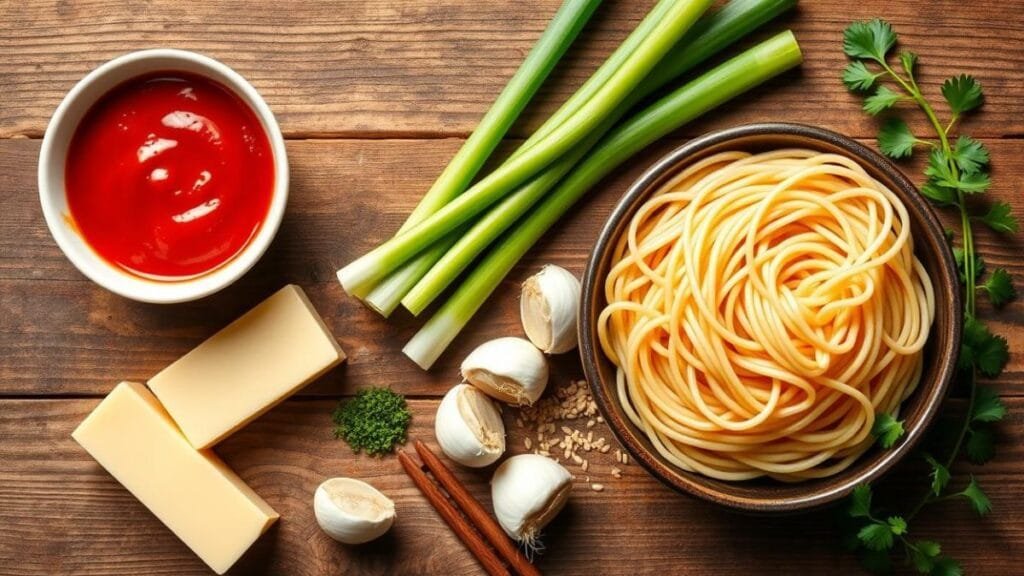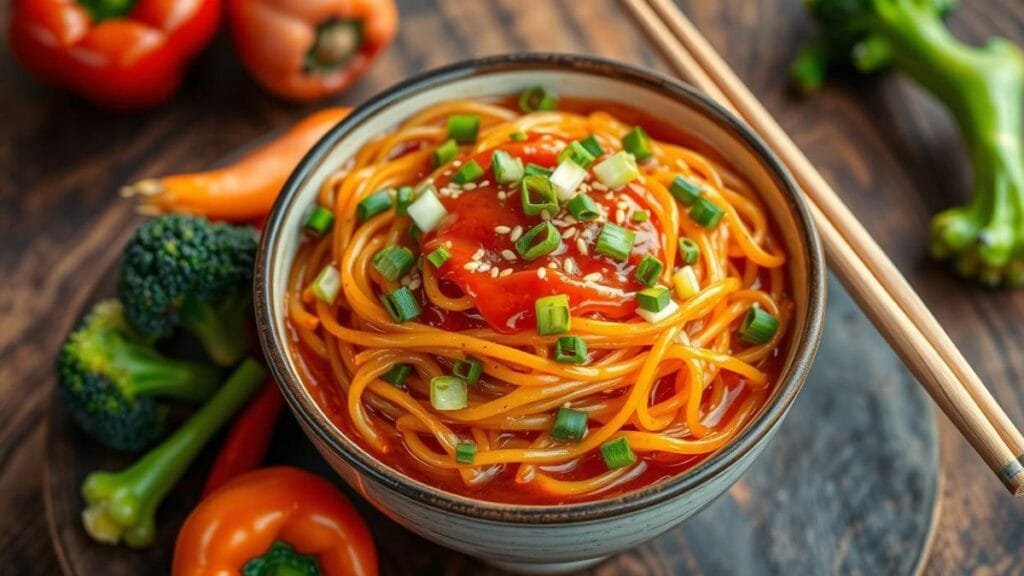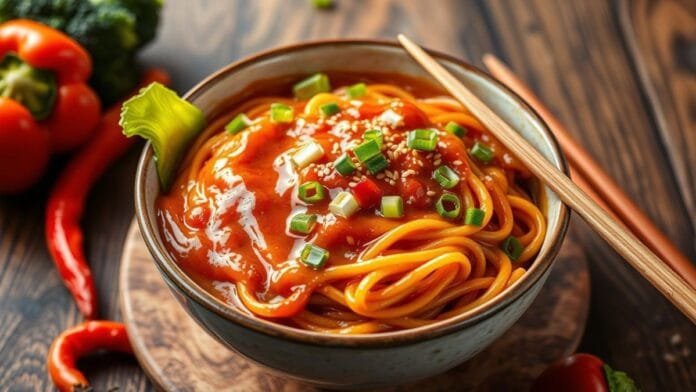I found the magic of gochujang buttered noodles on a cold evening. The spices sizzled and the Korean chili paste’s aroma filled my kitchen. It turned my cooking space into a journey that changed how I make quick, tasty meals.
These spicy noodle dishes are more than a recipe. They celebrate Korean cuisine’s bold flavors. Ready in just 30 minutes, they offer a burst of taste that satisfies hunger and curiosity. Gochujang adds a unique heat, blending spicy and sweet in every bite.
If you’re always on the go or love trying new foods, these noodles are for you. They’re full of veggies and rich in umami. This recipe shows the amazing depth of Korean cooking.
Gochujang: The Heart of Korean Cuisine
Gochujang is a treasure in Korean cooking. It turns simple dishes into amazing meals. Its spicy, sweet, and umami flavors have made it famous worldwide.
Traditional Fermentation Process
Making gochujang starts with fermented soybeans. Artisans mix glutinous rice, gochugaru chili powder, and soybeans. This mix ferments for months, making the flavors stronger.
- Ingredients are mixed in traditional clay pots
- Fermentation occurs under precise temperature conditions
- Sunlight exposure helps develop deeper flavor profiles
Spice Level Guide
Gochujang comes in different heat levels. You can find it from mild to very hot. This lets everyone enjoy its unique taste.
| Spice Level | Heat Intensity | Recommended For |
|---|---|---|
| Level 1 | Mild | Beginners, Subtle Flavor Seekers |
| Level 3 | Medium | Moderate Spice Lovers |
| Level 5 | Extremely Hot | Heat Enthuasiasts |
Cultural Significance
In Korean cooking, gochujang is more than a condiment. It’s a symbol of cultural heritage and skill passed down through generations. Chefs and home cooks love it for adding depth to dishes.
Gochujang is used in everything from traditional stews to new recipes. It shows that some ingredients are truly timeless.

Essential Ingredients for Perfect Gochujang Buttered Noodles
To make the perfect gochujang butter sauce, you need the right ingredients. These ingredients turn simple noodles into a dish to remember. The secret is using fresh, high-quality parts that blend well together.
Choosing the right ingredients is key to a great dish. Here’s what you’ll need:
- Noodle Base:
- Ramen noodles
- Udon noodles
- Soba noodles
- Spaghetti (for a Western twist)
- Flavor Enhancers:
- ¼ cup gochujang paste
- ⅓ cup butter
- 2 tablespoons honey
- 2 tablespoons rice wine vinegar
The gochujang butter sauce is the dish’s star. It mixes butter’s creaminess with gochujang’s rich flavors. This sauce makes simple noodles taste like a gourmet meal.
| Ingredient | Quantity | Purpose |
|---|---|---|
| Gochujang Paste | ¼ cup | Primary flavor base |
| Butter | ⅓ cup | Creamy texture |
| Garlic | 10 cloves | Aromatic depth |
| Sesame Oil | 2 tablespoons | Nutty undertone |
Pro tip: The New York Times named these noodles the most viral recipe of 2023. It shows that simple ingredients can make amazing dishes. With just 20 minutes of prep, you’ll have a meal that’s both impressive and tasty.
The Art of Balancing Flavors
Making the perfect korean comfort food is all about mixing tastes. Gochujang butter sauce is more than a simple sauce. It’s a mix of flavors that come together to create something special.
Sweet and Spicy Harmony
Finding the right mix of sweet and spicy is key. Maple syrup helps balance the heat of gochujang. This mix of flavors makes your dish stand out.
Umami Enhancement Techniques
- Incorporate soy sauce for deep, rich undertones
- Add miso paste to amplify savory notes
- Use oyster sauce for extra depth
Acid and Salt Balance
Sherry vinegar adds a bright touch to your dish. It keeps the gochujang butter sauce from feeling too thick. A little vinegar makes all the flavors pop.
Remember, it’s all about trying new things. Everyone likes different flavors. So, feel free to tweak the recipe to make it your own.
Step-by-Step Preparation Guide
Making gochujang buttered noodles is simple. I’ll show you how to turn basic ingredients into a tasty meal in just 10 minutes.
- Prepare a large pot of salted water for cooking pasta
- Follow package instructions carefully when cooking noodles
- Cook pasta until it’s slightly underdone (al dente)
- Reserve 1/2 cup of pasta cooking water before draining
While the pasta cooks, start making the gochujang sauce. Mix 2 tablespoons of gochujang paste, 2 tablespoons of rice vinegar, and 1.5 tablespoons of agave syrup in a bowl.
In a skillet, melt 3 tablespoons of vegan or dairy butter. Add 6 minced garlic cloves and sauté until fragrant. This step adds a rich flavor to the noodles.
Once the noodles are done, mix them with the sauce. Toss until every strand is coated. If the sauce is too thick, add some pasta cooking water to get a smooth texture.
| Ingredient | Quantity | Notes |
|---|---|---|
| Frozen Udon Noodles | 9 oz | Can substitute with dried pasta |
| Gochujang Paste | 2 tbsp | Adjust for spice preference |
| Butter | 3 tbsp | Vegan option available |
Pro tip: Add protein like tofu or garnish with green onions and toasted sesame seeds for extra nutrition. This recipe is very versatile!

Customizing Your Gochujang Buttered Noodles
Making the perfect gochujang buttered noodles is all about making it your own. This dish is super versatile, letting you try out different ingredients and flavors. You can add your own twist by mixing in various proteins, veggies, and sauces.
Let’s explore the fun world of customization. It turns a simple noodle dish into a true culinary masterpiece.
Protein Options to Elevate Your Dish
- Thinly sliced chicken breast
- Crispy tofu cubes
- Succulent shrimp
- Ground beef or pork
- Tempeh for a plant-based protein boost
Vegetable Additions for Color and Nutrition
- Fresh garlic sautéed spinach
- Roasted broccoli florets
- Crisp snap peas
- Sautéed mushrooms
- Julienned carrots
Sauce Variations to Tantalize Your Taste Buds
| Sauce Style | Key Ingredients | Flavor Profile |
|---|---|---|
| Creamy Vegan | Vegan butter, tahini, gochujang | Smooth, rich, slightly spicy |
| Nutty Delight | Peanut butter, gochujang, honey | Sweet, spicy, complex |
| Tangy Twist | Rice vinegar, gochujang, sesame oil | Bright, zesty, umami |
By trying out these customization options, you’ll make a gochujang buttered noodles dish that’s truly yours. The most important thing is to have fun and experiment in the kitchen!
Serving Suggestions and Pairings
Presenting gochujang buttered noodles right can turn a basic dish into a feast for the eyes and taste buds. Serve these noodles hot. Choose garnishes that boost both taste and looks.
Adding garnishes is essential to make the dish more interesting. Sprinkle toasted sesame seeds on top. They add a nutty flavor that goes well with the Korean chili. Here are some great garnish ideas:
- Sliced green onions for fresh brightness
- Soft-boiled egg for rich, creamy texture
- Crispy fried shallots for extra crunch
- Drizzle of chili oil for additional heat
Pairing your noodles with the right side dishes makes the meal complete. Here are some good options:
| Side Dish | Flavor Profile |
|---|---|
| Kimchi | Tangy and spicy |
| Pickled radishes | Crisp and acidic |
| Fresh spring rolls | Light and refreshing |
These pairings not only add to the meal’s taste but also bring a traditional Korean dining feel. It celebrates the rich food culture behind gochujang buttered noodles.
Storage Tips and Leftover Management
Mastering meal prepping for your gochujang buttered noodles ensures delicious work lunches all week. Proper storage and reheating techniques keep the dish’s flavor and texture perfect.
Optimal Container Selection
Choosing the right storage container is key for keeping your noodles fresh. I suggest using airtight glass or BPA-free plastic containers with tight lids. Having separate containers for noodles and sauce helps avoid soggy textures.
- Glass containers with tight-sealing lids
- Microwave-safe storage options
- Containers with compartment dividers
Smart Reheating Methods
Reheating gochujang buttered noodles needs gentle methods to keep their taste and texture. Add a bit of water or broth when warming to avoid drying out.
| Reheating Method | Recommended Technique | Time |
|---|---|---|
| Stovetop | Medium heat, constant stirring | 3-4 minutes |
| Microwave | 50% power, intermittent stirring | 1-2 minutes |
Effective Meal Prep Strategies
For great work lunches, prep components separately. Store sauces, proteins, and noodles in different containers. Assemble just before eating for the best texture and freshness.
Remember, gochujang buttered noodles can last up to 5 days in the fridge. By following these tips, you’ll enjoy tasty, restaurant-quality meals at home.

Conclusion
My journey with gochujang buttered noodles has changed my cooking forever. This spicy dish is more than just food; it’s a mix of Korean tradition and modern flair. It brings comfort and a new taste to home cooks.
This recipe is incredibly versatile. It suits anyone, from busy professionals to passionate chefs. The creamy butter, spicy gochujang, and noodles come together in a dish that’s both cozy and exciting.
I suggest you try this recipe and make it your own. Gochujang buttered noodles inspire creativity in the kitchen. You can add your favorite proteins or adjust the spice to match your taste. It’s not just a recipe; it’s a way to explore Korean cooking.
When you start making gochujang buttered noodles, remember it’s about fun and sharing. Be open to new things, trust your taste, and enjoy the process. Cooking is a joy that brings people together.
Gochujang Buttered Noodles FAQ
What is gochujang, and why is it important in this dish?
Gochujang is a Korean chili paste made from soybeans, rice, and chili flakes. It adds sweet, spicy, and umami flavors to the noodles. You can pick the spice level to your liking.
Can I make this dish vegetarian or vegan?
Yes! Use plant-based butter and tofu or edamame for protein. Make sure all ingredients are vegan-friendly. This dish fits many diets.
How spicy are gochujang buttered noodles?
The spice level depends on the gochujang. It ranges from mild to very hot. Choose your spice level or adjust the amount for the perfect heat.
What type of noodles work best for this recipe?
Udon, soba, ramen, or spaghetti are great choices. Pick a thick, chewy noodle for the best sauce hold.
How long can I store leftover gochujang buttered noodles?
Store leftovers in an airtight container in the fridge for up to 5 days. Keep noodles and sauce separate for better flavor. Reheat with a bit of water or broth to keep the sauce right.
Can I add protein to this dish?
Yes! Try tofu, chicken, shrimp, ground meat, or edamame. This dish is very flexible, so add your favorite protein.
What are some good side dishes to serve with gochujang buttered noodles?
Serve with kimchi, pickled radishes, or fresh spring rolls. Top with green onions, sesame seeds, or a soft-boiled egg for extra flavor and texture.
How can I adjust the sauce if it’s too spicy?
Add more maple syrup or agave nectar for sweetness. Rice vinegar or lime juice can also help. Or, use a milder gochujang or less of it.














